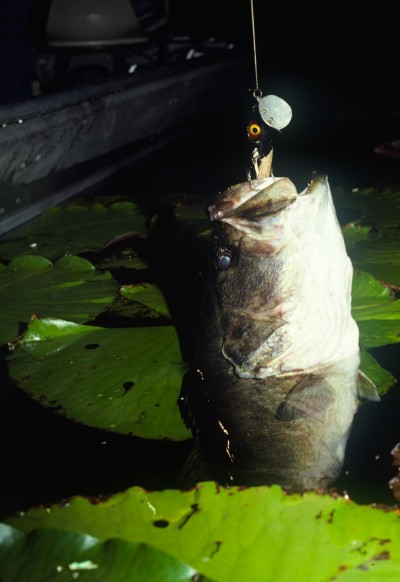Nighttime Fishing for Summer Lunker Bass
John E. Phillips 06.23.14

The daytime temperatures had climbed to over 100 degrees. Even at night, the mist coming off the water felt more like steam than a cool breeze. As I cast a black, wooden Musky Jitterbug, the constant plop, plop, plop, plop sound it made was interrupted by an explosion. I used 55-pound-test, braided line and a pool-cue-sized rod to set the hook on the fish hard. As I saw the 8-1/2-pound bass’ head, I reeled furiously, dragged the big largemouth to the boat and then removed the hooks and let the lunker go. To catch a trophy-sized bass during the summer months, fish at night. I learned this lesson while fishing with the late LJ Brasher of Opelika, Alabama, who at that time had caught more than 500 largemouth that weighed 10 pounds or more at night and had documented each of his catches in a logbook.
Brasher’s nighttime secrets
- Fish when no one else fishes with a bait big enough for a large bass to eat and with tackle strong enough to land a lunker.
- Fish ponds that many anglers fish in the daytime, but not for bass or at night.
- Use equipment with the power to set the hook and to get the fish out of the cover and into your boat. According to Brasher, big-bass equipment should consist of heavy line, big baits, stout rods, and Herculean reels.
- Fish farm ponds, golf courses, municipal-park ponds, state public-fishing lakes and stock ponds—all of which generally receive the least amount of fishing pressure—either from the bank, from a boat or by wading. They’re usually heavily stocked with bass and rarely have anglers who use the tackle and techniques required to catch very big bass.
- Locate lunker largemouth after dark in old, oxbow lakes off main river systems or even large reservoirs that receive daylight fishing pressure but rarely after dark.

Other nighttime baits and tactics
Although the big, black Musky Jitterbug by Arbogast may be the number-one nighttime bass bait in America, other lures will call sound-sensitive hawgs from the cover during the night, if they make sounds and provide visual wakes. When the reliable Heddon Lucky 13 is cast and pops across the surface of the water, the bass will see the splash and follow the trail. On bright nights when the moon’s full and seeing the bank and the cover is easy, I like to fish a large seven- to 10-inch plastic worm or snake on top rigged Texas-style. I’ll cast the lure into the grass, weeds, or cover and let it swim out. Many nighttime anglers also prefer sub-surface lures such as pig-n-jigs or spinnerbaits.
Pat Cullen’s techniques
I had a phone call from an angler in Valdosta, Georgia, who said he’d developed some new strategies for fishing at night. After meeting Pat Cullen, he explained to me he was interested in learning how to fish for bass at night, because he had a disease of the eyes that had caused him to go blind. “I believe if I learn how to fish at night, then I can continue to fish. I’ve learned the lakes close to my home. Fishing the Jitterbug lets me hear my bait as it comes across the water. When I fish, I listen to the lake’s sounds. Usually one area of the lake will have the most frogs croaking, the most crickets chirping and the most bass breaking water. By spending the majority of my fishing time in that section of the lake, I generally catch the most and the biggest bass at night.”
After-dark spotted bass
Although most of the methods we’ve discussed are designed to catch the biggest largemouth bass, certain strategies have proven successful for taking very large spotted bass at night. In 1978, Phillip Terry of Decatur, Alabama caught an eight-pound, 15-ounce spotted bass from Lewis Smith Reservoir on a large, homemade spinner bait at night. That fish broke the existing world record.
At night when current isn’t being pulled through a lake, big spotted bass seem to be somewhat more mobile and move away from their rocky hideouts to attack baitfish more frequently. Fishing spinnerbaits vertically with big blades and large trailers—preferably a 1/4-ounce to a 1/2-ounce with a jumbo pork frog and large willow-leaf blades—will catch big spots along rocky bluffs, cliffs, and points at night. Cast the lure straight into the bluffs, and allow the lure to fall vertically straight down the bluff. When the spot hits the lure, reel quickly, and set the hook. Slider worms also produce big spotted bass after dark.
Monster moonlight bronzebacks
If you’re fishing a major reservoir where current is generated in daylight hours during the summer months, smallmouths often will hold in the deep water along an old river channel, which is the coolest and most-oxygenated water in the lake and often the best habitat. At night during the summer, the smallmouths will move up into the stumps and flats along the edges of the old river channel. They also tend to move onto the rocky points and feed on tops of the points, instead of behind the points when current isn’t being pulled through the lake at night. To take these big smallmouths after dark, use pig-n-jigs or dark-colored spinnerbaits. Cast to the cover or to the points, and retrieve slowly near the bottom.
To learn more about bass fishing, get John E. Phillips’ Kindle eBooks.

